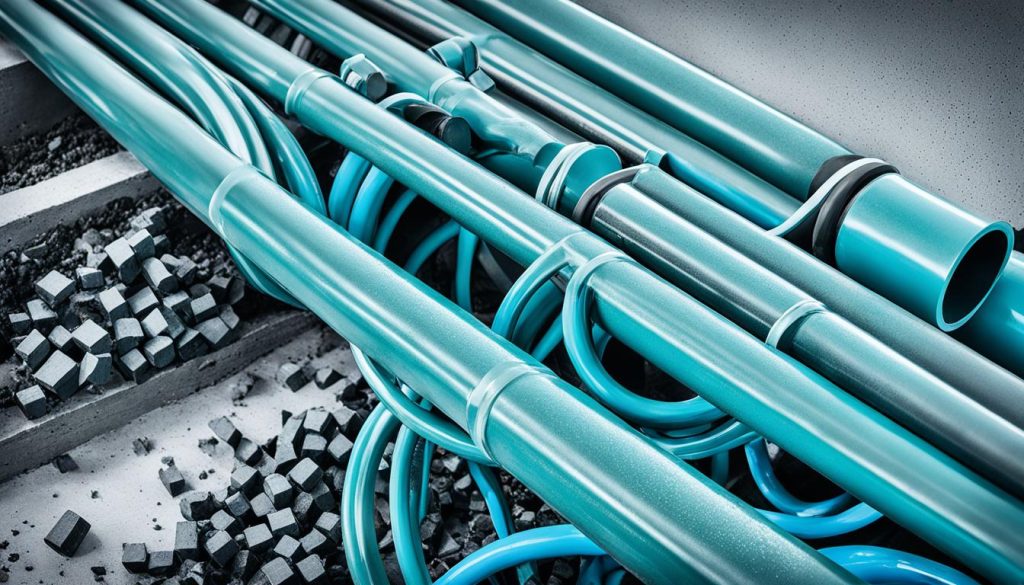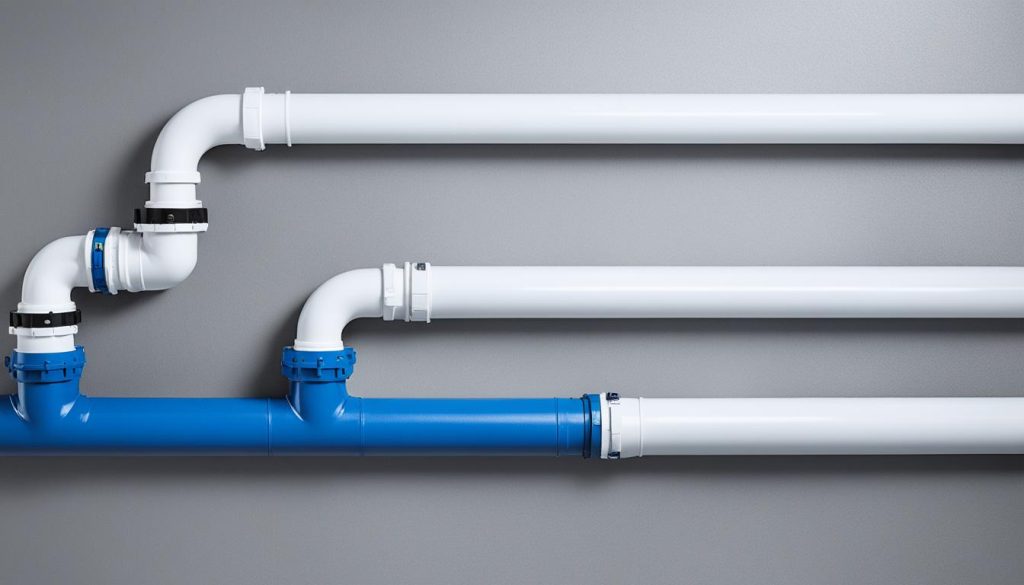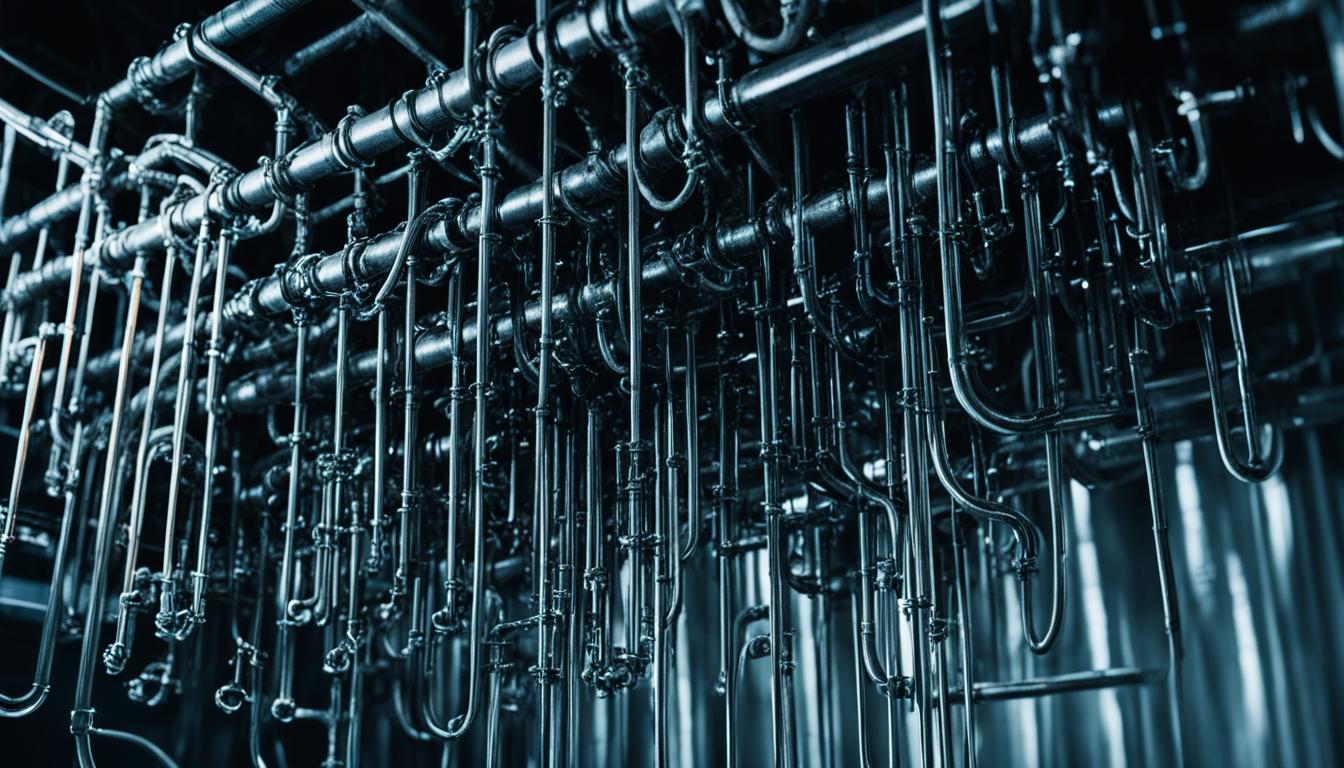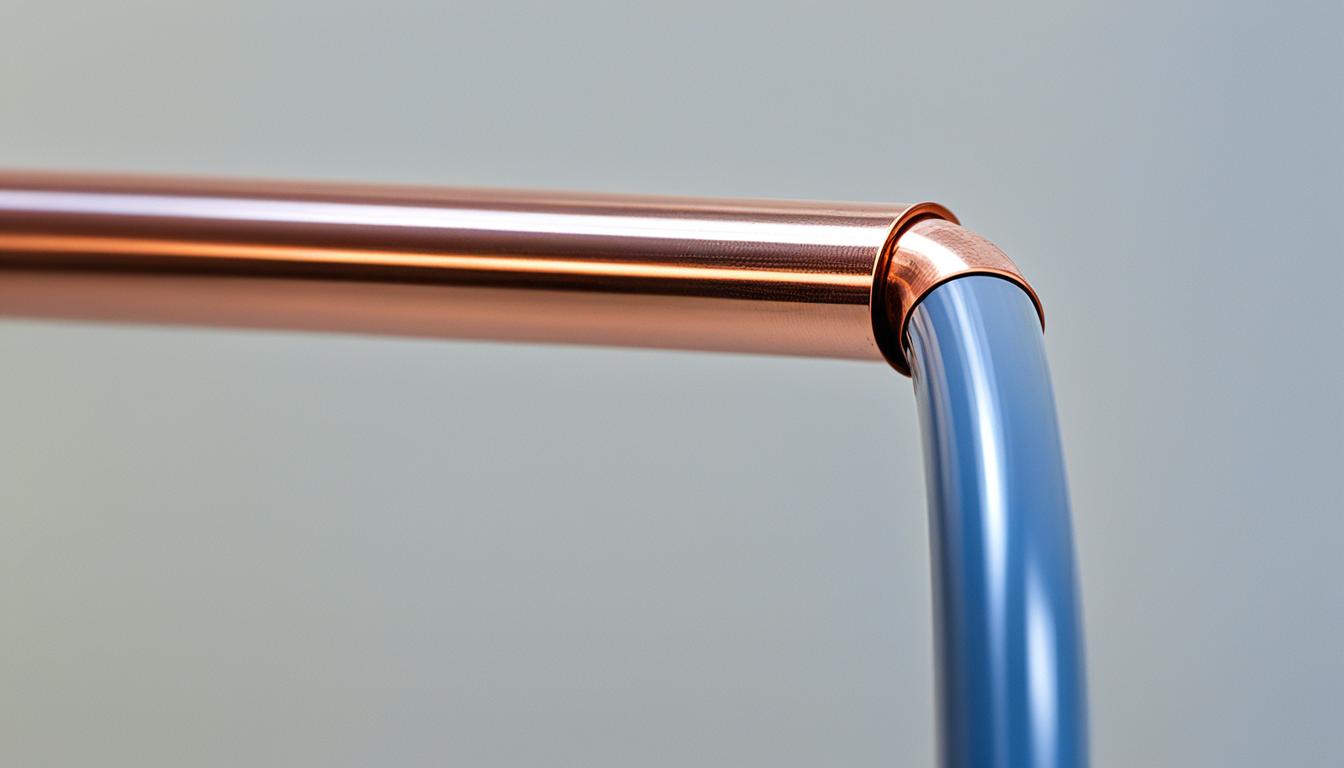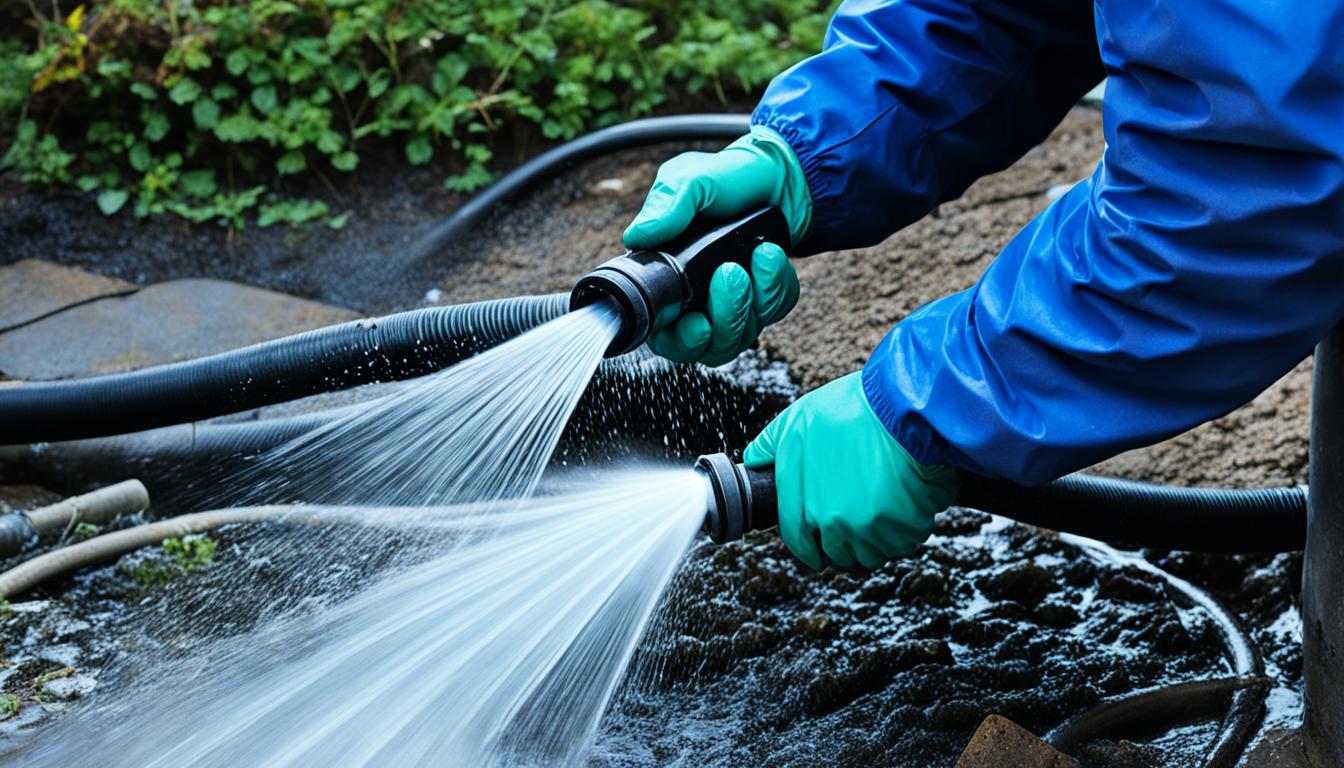ABS Pipe Uses in Modern Plumbing | Quick Guide
Did you know that ABS pipes are revolutionizing modern plumbing systems across Canada? From residential homes to commercial buildings, ABS pipes are being recognized for their unparalleled durability, versatility, and ease of installation. Whether you’re a homeowner or a professional plumber, understanding the benefits and applications of ABS pipes is crucial for ensuring efficient and long-lasting plumbing systems.
ABS pipes are commonly used in drainage, waste, and vent (DWV) systems, offering superior performance and reliability. But how do they compare to other commonly used plumbing materials like PVC pipes? In this comprehensive guide, we’ll delve into the advantages of ABS pipes, their installation process, and the key factors to consider when choosing between ABS and PVC pipes. Let’s explore the world of ABS pipes and how they are transforming the plumbing industry in Canada.
Key Takeaways:
- ABS pipes are widely used in modern plumbing for drainage, waste, and vent (DWV) systems.
- ABS pipes offer durability, versatility, and ease of installation.
- Comparing ABS pipes to PVC pipes can help determine the best choice for specific plumbing needs.
- When choosing ABS pipes, consider factors such as cost, strength requirements, and building codes.
- Researching reputable ABS pipe suppliers in Canada ensures access to high-quality products for plumbing projects.
ABS Pipe Installation
Installing ABS pipes is a simple and efficient process that requires minimal time and specialized tools. With the use of solvent cement glue, ABS pipes can be easily cut and joined together without the need for a primer. Here’s a step-by-step guide to ABS pipe installation:
Cutting and Deburring
Before starting the installation process, it is crucial to cut the ABS pipe squarely and deburr it for a proper fit. This ensures a tight and secure connection. Use a pipe cutter or a hacksaw to make clean and precise cuts.
Preparing the Pipe Surface
Prior to applying the glue, it is essential to clean the surface of the ABS pipe thoroughly. Remove any dirt, dust, oil, water, or identification stickers, as they can hinder the bonding process. A clean and dry surface will promote a strong and reliable joint.
Applying the Glue
When applying the solvent cement glue, it is recommended to use ABS pipe glue specifically designed for joining ABS pipes. Apply the glue to both surfaces that will be joined together. Make sure to complete the joint within 30 seconds after applying the glue to ensure a secure bond.
Allowing the Joint to Set
After making the joint, it is important to allow sufficient time for it to set and cure properly. The setting time may vary depending on the ambient temperature and humidity. Generally, it is advisable to let the joint cure for at least 30 minutes to 24 hours before subjecting it to any pressure or testing.
Threaded ABS Joints
For threaded ABS joints, it is recommended to use Teflon tape or other ABS approved thread sealants instead of petroleum-based sealant compounds. This ensures leak-free connections and prevents the degradation of the ABS pipe material.
Transition Fittings
In certain cases, it may be necessary to connect ABS pipes to other types of piping systems. Transition fittings are available to facilitate this connection process. These fittings provide a reliable and secure transition point between ABS pipes and other materials, allowing for a seamless integration of the plumbing system.
To summarize, ABS pipe installation is a straightforward and uncomplicated process that can be completed with basic tools and solvent cement glue. By following the proper procedures and guidelines, homeowners can ensure a successful and durable plumbing system. Whether it’s for residential or commercial applications, ABS pipes offer a reliable and versatile solution for a wide range of plumbing needs.
ABS Pipe Advantages
ABS pipes provide numerous advantages in plumbing applications. Their durability and strength make them highly suitable for demanding environments, including sewage systems. ABS pipes are resistant to chemicals and corrosion, ensuring long-lasting and reliable performance.
One of the key advantages of ABS pipes is their lightweight construction. This makes them easier to handle and install compared to other materials, saving both time and effort during the plumbing process. Additionally, ABS pipes have excellent flow characteristics, minimizing the risk of clogs and allowing for efficient drainage.
Compared to PVC pipes, ABS pipes offer enhanced flexibility. This flexibility enables them to be maneuvered more easily around tight spaces, making them particularly desirable for plumbing installations that require bends or turns. ABS pipes meet industry standards and specifications, ensuring their reliability and compatibility with other plumbing components.
| Advantages of ABS Pipes | ABS Pipe Specifications |
|---|---|
| 1. Durability and strength | Material: Acrylonitrile Butadiene Styrene (ABS) |
| 2. Resistance to chemicals and corrosion | Color: Black |
| 3. Lightweight and easy to handle | Standard Sizes: 1/2″ to 6″ |
| 4. Excellent flow characteristics | Pressure Rating: Varies based on diameter |
| 5. Enhanced flexibility for tight spaces | Temperature Range: -29°C to 60°C (-20°F to 140°F) |
ABS Pipe vs PVC Pipe
When it comes to choosing between ABS and PVC pipes, there are several factors to consider. ABS pipes are commonly used for heavy-duty applications such as underground and sewage systems, while PVC pipes are typically used for water lines and indoor plumbing. ABS pipes offer more flexibility, making them easier to maneuver around tight spaces, whereas PVC pipes are more rigid and better suited for straight runs.
While ABS pipes are slightly more expensive than PVC pipes, the overall cost is comparable due to the additional primer required for PVC pipe installation. The table below provides a comparison of ABS and PVC pipes in terms of advantages, dimensions, and sizes:
| ABS Pipe | PVC Pipe |
|---|---|
| More heavy-duty | Typically used for water lines and indoor plumbing |
| More flexible | More rigid |
| Slightly more expensive | Comparable cost with additional primer |
| Available in various dimensions and sizes | Available in various dimensions and sizes |
It is crucial to consider the specific requirements of your project and consult local building codes when deciding between ABS and PVC pipes. Both types of pipes have their advantages and are suitable for different applications. By understanding the differences and considering your plumbing needs, you can make an informed decision.
ABS Pipe Suppliers
Looking for reliable ABS pipe suppliers in Canada? Look no further! There are several reputable suppliers across the country that offer a wide range of ABS pipes and fittings to meet the needs of different plumbing projects. Whether you’re a homeowner or a professional plumber, finding the right supplier is crucial to ensure the quality and durability of your plumbing system. Here are some well-known ABS pipe suppliers in Canada that you can consider:
- ABC Supply Co., Inc.
- Home Hardware
- RONA
These suppliers have established themselves in the industry and are trusted for their quality products. They offer a comprehensive selection of ABS pipes in various sizes and dimensions, ensuring that you can find the perfect fit for your specific project requirements. By researching and comparing different suppliers, you can find the best quality and pricing options for ABS pipes.
Remember, when choosing an ABS pipe supplier, it’s essential to prioritize quality, reliability, and customer service. Look for suppliers who prioritize customer satisfaction and have a proven track record of delivering excellent products. By choosing a trusted supplier, you can have peace of mind knowing that you’re getting the best ABS pipes for your plumbing needs.
Conclusion
After exploring the wide range of benefits and applications of ABS pipes, it is clear that they are an excellent choice for modern plumbing systems. The durability and strength of ABS pipes make them suitable for various plumbing systems, including drainage, waste, and vent systems. Their ease of installation, thanks to a simple cut and join process with solvent cement glue, makes them a convenient option for both professionals and DIY enthusiasts.
One of the standout features of ABS pipes is their flexibility, which allows for easy maneuverability in tight spaces. This versatility is especially valuable when navigating around existing structures or making adjustments to a plumbing layout. Additionally, ABS pipes offer excellent resistance to chemicals and corrosion, ensuring a long-lasting and robust plumbing system.
When making the decision between ABS and PVC pipes, it is important to consider factors such as the specific application, durability requirements, cost, and local building codes. However, with its numerous advantages, including lightweight construction and excellent flow characteristics, ABS pipes emerge as a highly favorable option. By opting for high-quality ABS pipes from reputable suppliers, homeowners can ensure the longevity and efficiency of their plumbing systems.
Source Links
- https://plumbinghelp.com/joining-abs/
- https://www.plumbingone.com/blog/abs-vs-pvc-piping-which-is-better
- https://www.thespruce.com/basic-types-of-plumbing-pipes-1822487
- Investing Wisely: How Windows & Doors in Boost Property Value and Financial Health - April 24, 2025
- The Financial Impact of Personal Injuries: Why Legal Help Matters for Business Owners - April 16, 2025
- The Hidden Financial Costs of Domestic Assault: What Business Owners Need to Know - April 16, 2025
